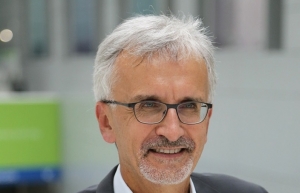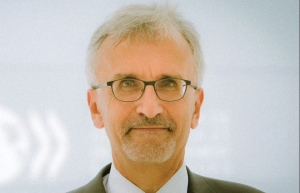Preparedness crucial in safeguarding banking sector
Factors potentially triggering the turmoil include monetary tightening, weak economic conditions, mismanagement, loss of confidence, maturity and currency mismatches, as well as instances of outright fraud and criminal activities.
Most banks are resilient and avoid such difficulties -- but not all. Consequently, financial authorities must maintain preparedness to intervene whenever necessary, all while avoiding unintended consequences that could potentially sow the seeds of future banking crises.
Global banking stress
The current banking turmoil is largely due to the cycle of monetary tightening. Since early 2022, central banks have been quick to increase interest rates to bring inflation under control.
In the United States, the effective Fed Funds rate increased by 500 basis points in just 14 months, a speed never observed since 1988.
The European Central Bank has raised its policy rates by 400 basis points since mid-2022 and indicated that more rate hikes are forthcoming. Commercial banks unprepared for this tightening have faced various difficulties. Bonds held in their portfolio at market prices suddenly lost value. Depositors have been quick to withdrawal deposits when alarmed by rumour. Weak housing markets and depressed commercial properties have also become risky exposures.
Most banks around the world are tightly regulated and well managed – and have suffered only temporary setbacks.
However, several mid-sized regional banks in the United States were ill-prepared. Silicon Valley Bank specialised in startups collapsed in late March 2023 and was acquired by First Citizens BancShares.
New York-based Signature Bank collapsed a few days later and was closed by financial regulators, with assets acquired at a large discount by New York Community Bank.
 |
| Patrick Lenain, CEP senior associate |
In early May, San Francisco First Republic Bank faced a collapse of its stock price and large deposit withdrawals; it was closed by regulators and its assets were acquired at a deep discount by J.P. Morgan. It was the second-largest bank collapse in the United States, after Washington Mutual in 2008.
No other US regional bank has failed so far, although the stocks of banks PacWest and First Horizon have also been under severe pressure, while the stocks of Zions and Comerica have closed lower.
Across the Atlantic, Zurich-based Credit Suisse suffered severe liquidity losses and a rapid fall in its decline stock price in March, it was eventually acquired by Swiss rival Union Bank of Switzerland.
Vietnamese banks resilient
Apart from US mid-sized banks and Switzerland, bank distress has been well contained. No sign of bank distress has emerged in Vietnam, in contrast to past episodes of banking turmoil. Following the global financial crisis of 2008, Vietnamese banks faced a wave of non-performing loans. More recently, a private bank was subjected to a panic-induced run as depositors grew concerned about the implications of a corruption crackdown.
These crises have served as valuable lessons for the State Bank of Vietnam. The central bank has implemented tight regulatory requirements. Major banks are now required to meet regulations akin to Basel II. As a result, capital buffers have significantly improved, prompting the Organisation for Economic Co-operation and Development to note in its latest report on Vietnam that a minimum capital adequacy ratio of 8 per cent "was applied to 85 institutions out of 96 commercial banks," with joint-stock commercial banks and foreign banks' branches surpassing this minimum regulatory requirement.
The State Bank of Vietnam has also improved the resolution framework of credit institutions’ non-performing loans.
Following the global financial crisis, bad loans were transferred in 2013 to the Vietnam Asset Management Corporation, a so-called “bad bank” with state backup that provides the time necessary to work out debt restructuring plans with indebted borrowers.
Tighter regulation has kept Vietnam’s non-performing loan ratio at the low level of 2.05 per cent in December 2022, below levels observed in Thailand at 3 per cent and Indonesia at 2.6 per cent.
Strong capital adequacy and low non-performing loans are healthy signs, but not a full-proof guarantee of bank resilience. Preliminary reports suggest that the non-performing-loan ratio of Vietnam’s banks increased to 2.88 per cent at end-March 2023 -- a worrying sign of tight credit conditions. Financial supervisors must therefore be prepared to intervene, if necessary.
The recent turmoil in the United States and Switzerland provides useful lessons on preparedness.
Deposit insurance
Most countries insure the deposits of bank depositors to strengthen confidence and protect the population in the case of of bank failure.
In Vietnam, the maximum amount payable for all insured deposits in accordance with the Law on Deposit Insurance is VND125 million (about $5,435) for each depositor at one of the insured institutions. This is enough to protect the deposits of many individual depositors, but neither upper-income customers and businesses.
During emergency rescues, financial authorities often decide to guarantee all deposits, as a precautionary measure to instil confidence and stop the panic.
In the United States, the Federal Deposit Insurance Corporation insures deposits up to $250,000 per account. This is enough for most Americans, but businesses and other large organisations may hold over $250,000 at a given time.
As of the end of 2022, about 43 per cent of all bank deposits were uninsured. When Silicon Valley Bank and Signature Bank collapsed, US Treasury Secretary Janet Yellen invoked a “systemic risk exception” and decided to cover all deposits in these two banks, a decision that helped to stem the panic from spreading. When First Republic Bank failed, all deposits, insured and uninsured, were also safeguarded, so no depositors lost money. While this remains implicit, depositors in other banks may expect that they would not lose money either, in case of further bank turmoil.
Broadening the coverage of deposit insurance, as done recently, has obvious advantages in calming down depositors and protecting them against losses. However, such blanket protection creates a “moral hazard” – in other words, a lack of vigilance from depositors who do not assess the safety of their deposits as they consider them fully insured.
Central bank refinancing
In addition to full insurance coverage for deposits, emergency bank rescue efforts often involve the implementation of new lending programmes.
For instance, in the United States, the Federal Reserve established the Bank Term Funding Program.
Under this programme, banks can access central bank liquidity by pledging securities such as Treasuries, mortgage-backed bonds, and other debt as collateral.
Notably, these securities are valued at face value rather than their depreciated market value. This approach enables banks to fulfil customer withdrawal requests without being compelled to sell securities at depressed market prices, thereby mitigating substantial losses and preserving their capital adequacy.
The Bank Term Funding Program has emerged as an attractive option for banks. By mid-May 2023, the Federal Reserve had provided a significant sum of $87 billion in funding through this programme. Such support has been instrumental in bolstering banks facing substantial deposit withdrawal requests, ensuring their stability during challenging times.
Similarly, in Switzerland, the Swiss National Bank took measures to assist Credit Suisse during a period of financial strain. The bank was allowed to borrow up to 50 billion Swiss francs through a covered loan facility and a short-term liquidity facility. These measures provided Credit Suisse with the necessary time to seek a long-term solution, while also enabling the bank to meet deposit withdrawal requests during the interim period.
Protecting depositors with special central bank refinancing windows is understandable. Protecting bank management, shareholders, and junior bondholders is not. These stakeholders have responsibility for the bank demise, and need to face the consequences, rather than benefit from full bailouts.
Bank acquisitions
In times of banking turmoil, swift action is paramount. Emergency responses involve expeditiously organising the acquisition of distressed banks, often within a short timeframe, such as over a weekend. It is imperative that depositors can access their bank branches immediately after the reorganisation, typically on Monday morning.
This is a complex task. It entails assessing the troubled bank's assets, liabilities, capital, and risk exposure. Regulatory authorities must grant approval for the acquisition to proceed. Identifying a suitable acquiring bank capable of absorbing the troubled bank's assets and liabilities is essential. Negotiating the terms of the acquisition and conducting thorough due diligence are additional steps in the process. If necessary, recapitalisation and restructuring of the troubled bank may be required. Once these steps are completed, the distressed bank's assets and liabilities are transferred to the acquiring bank. These emergency measures are followed by a longer-term process of integration, alignment, and staff reorganisation.
However, it is important to note that bank acquisitions often lead to the formation of larger banks, exacerbating the issue of "too big to fail" and reducing competition in the market. To address this, financial regulators must ensure that financial markets remain open to new participants, fostering sufficient dynamism in bank finance. This is crucial to achieving sustainable prosperity, particularly in middle-income countries like Vietnam.
 | Can Vietnam achieve its goals on net-zero emissions? Vietnam’s economic achievements have been impressive over recent decades but greenhouse gas emissions have risen alongside them. Patrick Lenain, former assistant director at the Organisation for Economic Co-operation and Development, looks at the carbon market for this country moving forward as it tries to meet major emission-reducing targets. |
 | Assessing risks of inflation for everyday life in Vietnam While inflation has soared around the world, Vietnam has successfully kept it low. However Patrick Lenain, senior associate at the Council on Economic Policies, writes that it is too soon to claim victory because new bursts in food prices could occur, putting at risk the health of undernourished people. |
 | Developments for Vietnam to watch in midst of bank crisis The banking system is bracing for difficulties after the events surrounding Silicon Valley Bank, Credit Suisse, and others. Patrick Lenain, senior associate at the Council on Economic Policies, shared his views on what should Vietnam watch for during this period. |
 | OECD: Reforms can boost economic and social progress The Organisation for Economic Cooperation and Development (OECD) has published its Economic Survey of Vietnam – a first-ever comprehensive study of the country’s economic, financial, social and environmental trends. Patrick Lenain, CEP senior associate, analyses the outcomes. |
What the stars mean:
★ Poor ★ ★ Promising ★★★ Good ★★★★ Very good ★★★★★ Exceptional
Related Contents
Latest News
More News
- Vietnam GDP posts second-strongest growth since 2011 (January 06, 2026 | 08:35)
- Double-digit GDP growth within reach with shift to higher-value expansion (January 06, 2026 | 08:33)
- Ho Chi Minh City projects $10.5 billion remittance inflows in 2025 (December 31, 2025 | 18:58)
- Digital shift reshaping Vietnam’s real estate brokerages (December 31, 2025 | 18:54)
- New decree sharpens enforcement in securities market (December 31, 2025 | 18:53)
- Voluntary Sustainability Standards pave way for Vietnam’s agricultural exports (December 31, 2025 | 09:00)
- Gold market reform advances as SBV receives applications for bullion production (December 30, 2025 | 12:07)
- Textile apparel firms deliver robust earnings despite global tariff pressures (December 30, 2025 | 10:09)
- Ho Chi Minh City hits $8.37 billion in FDI (December 29, 2025 | 08:28)
- Tax sector wraps up 2025 and sets priorities for next year (December 25, 2025 | 14:00)

 Tag:
Tag:





















 Mobile Version
Mobile Version